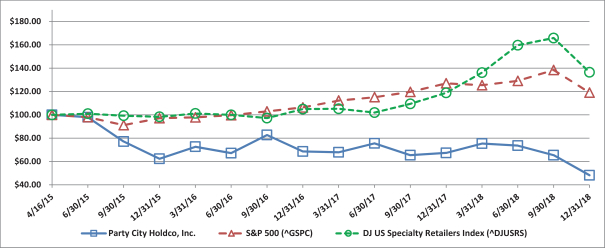In addition to our retail operations, we are also one of the largest global designers, manufacturers and distributors of decorated consumer party products, with items found in over 40,000 retail outlets worldwide, including independent party supply stores, mass merchants, grocery retailers, e-commerce merchandisers and dollar stores. Our products are available in over 100 countries with the United Kingdom (“U.K.”), Canada, Germany, Mexico and Australia among the largest end markets for our products outside of the United States. During 2018, our third-party wholesale revenues were $614 million.
The 2005 combination of Amscan, which focused on the wholesale market, and Party City, which focused on the retail market, represented an important step in our evolution. Since the acquisition of Party City, we have steadily increased the selection of Amscan merchandise offered in our Party City stores from approximately 25% to approximately 80% in 2018, allowing us to capture multiple levels of gross margin on a significant portion of our retail sales.
Industry Overview
We operate in the broadly defined $10 billion retail party goods industry (including decorative paper and plastic tableware, costumes, decorations, accessories and balloons), which is supported by a range of suppliers from commodity paper goods producers to party goods manufacturers. Sales of party goods are fueled by everyday events such as birthdays, baby showers, weddings and anniversaries, as well as seasonal events such as holidays and other special occasions. As a result of numerous and diverse occasions, the U.S. party goods market enjoys broad demographic appeal. We also operate in the $7 billion Halloween market, a portion of which overlaps with the $10 billion retail party goods industry. The Halloween market includes products that we sell such as costumes, candy and makeup. However, it also includes products and services which we do not supply, such as pumpkins, hay rides and haunted house tours.
The retail landscape for decorated party goods is comprised primarily of party superstores, mass merchants, e-commerce merchandisers, craft stores, grocery retailers, and dollar stores. The party superstore has emerged as a preferred destination for party goods shoppers, similar to the dominance of specialty retailers in other categories such as home improvement, pet products and sporting goods. This is typically due to the superstore chain’s ability to offer a wider variety of merchandise at more compelling prices in a convenient setting as well as the knowledgeable staff often found at superstores. Other retailers that cater to the party goods market typically offer a limited assortment of party supplies and seasonal items. Mass merchants tend to focus primarily on juvenile and seasonal goods, greeting cards and gift wrap; craft stores on decorations and seasonal merchandise; and dollar stores on general and seasonal party goods items.
Segments
We have two reporting segments: Retail and Wholesale. In 2018, we generated 74.7% of our total revenues from our retail segment and 25.3% of our total revenues from our wholesale segment.
Our retail operations generate revenue primarily through the sale of our party supplies, which are sold under the Amscan, Designware, Anagram and Costumes USA brand names, through our Party City stores, Halloween City stores and PartyCity.com. During 2018, 79% of the product that was sold by our retail operations was supplied by our wholesale operations and 23% of the product that was sold by our retail operations was self-manufactured.
Our wholesale revenues are generated from the sale of decorated party goods for all occasions, including paper and plastic tableware, accessories and novelties, costumes, metallic and latex balloons and stationery. Our products are sold at wholesale to party goods superstores (including our franchise stores), other party goods retailers, mass merchants, independent card and gift stores, dollar stores and e-commerce merchandisers.
Financial information about our business segments and geographical areas is provided in Note 15, Segment Information, to our consolidated financial statements in Part II, Item 8, “Financial Statements and Supplementary Data,” in this Annual Report on Form 10-K.
2
